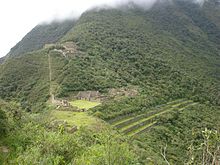The Sacred Valley of the Incas is a valley in the Southern Sierra in Peru that contains many famous and beautiful Inca ruins. It was called the Sacred Valley because it contains some of the best land in the region and was not a part of the Incan Empire but the property of the Emperor or Inca himself.
Cities
editMajor cities or major attractions in the Sacred Valley include:
- 1 Aguas Calientes — on the bottom of a magnificent valley, this town is the main gateway to Machu Picchu
- 2 Cusco — the unofficial capital of the region, Cusco is a fascinating city with beautiful colonial architecture built right atop Incan constructions. Although most of the Inca buildings have been replaced by the Spaniards, there are still some Inca walls and foundations to be seen in the center of Cusco.
- 3 Maras — on the main route to Incan sites of Salineras and Moray, Maras is an otherwise unremarkable dusty town
- 4 Ollantaytambo — one of the last Incan towns to fall, much of Ollantaytambo is laid out in the same way as it was in Inca times with extensive ruins worth seeing. In the town of Ollantaytambo houses can be seen which date from Inca times. The nearby ruins features agricultural terraces as well as military, religious and administrative sections. Admission with boleto turistico.
- 5 Patacancha — a traditional Quechua village in Cusco, near Ollantaytamb
- 6 Pisac — in addition to Machu Picchu-like ruins, it's the weekly market, in which locals from highlands gather with their fresh produce, that puts Pisac on the itinerary of many travellers. The mountain overlooking the village of Pisac is covered with terraces and several ruins. Well-worth a visit. Admission with boleto turistico.
- 7 Tipon — some of the most interesting agricultural terracing and water management developed by the Incas, all still in perfectly working condition. A group of agricultural terraces and irrigation channels. It is believed to be dedicated to agricultural experimentation as well as religious activities. Admission with boleto turistico.
- 8 Urubamba — a regional transportation hub, Urubamba also has a street market on offer
- 9 Yucay
Other destinations
edit
Other destinations near to or accessible from cities in the Sacred Valley include:
- 1 Choquequirao — a more remote and less-travelled alternative to Machu Picchu, much of Choquequirao has undergone reconstruction but still is impressive anyway (and not least because of the mighty views over Apurimac Valley). According to some this site is as impressive as Machu Picchu, but without the crowds. The only way in is a 4-day trek (two days each way).
- 2 Machu Picchu — one of the most spectacular sets of ruins in the world, a visit to Peru is not complete without a visit to this mysterious "lost city of Incas". The star attraction of the sacred valley. Also the endpoint of the Inca Trail.
- 3 Moray — terraced co-centric circles that were used for developing better agricultural crops by Incas. Amphitheater shaped terraces. It probably served as an agricultural laboratory and seed cultivation site.
- 4 Pikillacta - One of the few pre-Inca sites. It has been built by the Wari-culture. Admission with boleto turistico.
- 5 Puca Pucara - A small site. Which purpose it served is still unclear.
- 6 Qénqo - This site is hewn out of a rock. It probably served as religious shrine.
- 7 Sacsayhuamán - Cusco was envisioned to represent a puma with Sacsayhuaman as head. Large parts of the site has been destroyed in the colonial era as the Spaniards used the stones of the sites to build their own houses. What remains is still impressive. Admission with boleto turistico.
- 8 Tambomachay - A small ruin, which probably was a religious center, but could also be a military center. Walk back and visit Puca Pucara, Qénqo and Sacsayhuamán on the way back. (See Cusco). Admission with boleto turistico
Get in
editGet around
edit
Buses and minibuses (colectivos) are the way to get around for many destinations. However, to get to Aguas Calientes (to access Machu Picchu) the only ways in are by train or on foot.
See
editThe Sacred Valley is dotted with Inca Ruins, with Machu Picchu being the absolute star attraction. If you are in a hurry, try to visit at least Pisac and Sacsayhuaman.
- Salineras — ancient saltpans used by Incas in salt production. Thousands of salt pans nestled in a canyon that have been used to harvest salt from a spring for thousands of years.
Itineraries
edit- Inca Trail — the classic mountain trek to Machu Picchu
Do
editSee the valley. Although the various ruins are the undeniable highlight, a 4-5 hour bus tour of the loop Cusco-Chincheros-Urubamba-Pisac-Cusco shows truly spectacular landscapes, especially on clear days during the winter (May-September). Tours can be booked with various agencies, although it is cheapest to just take buses between the various cities (and you can start in any of them).
There are many beautiful towns in the Sacred Valley that contain great landscapes, traditional restaurants, hotels/hostels and local markets. The largest ones are Pisac, Calca, and Urubamba.

